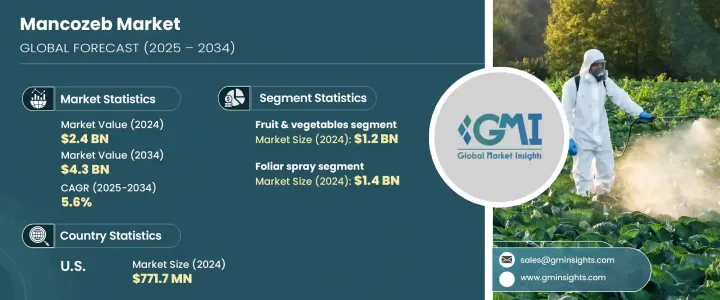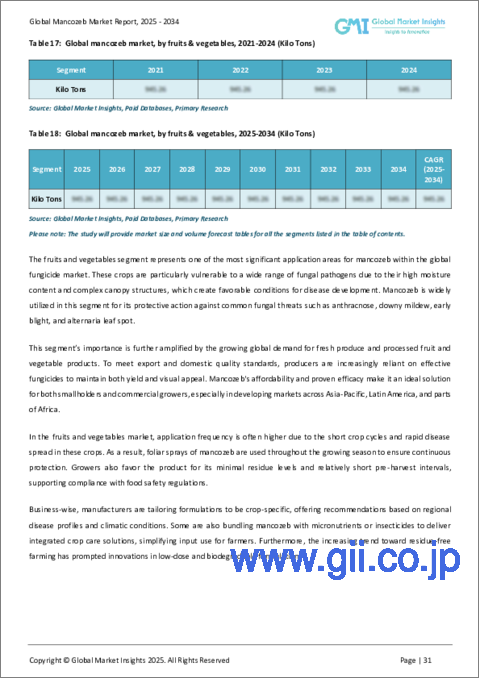|
|
市場調査レポート
商品コード
1740800
マンコゼブの市場機会、成長促進要因、産業動向分析と2025年~2034年予測Mancozeb Market Opportunity, Growth Drivers, Industry Trend Analysis, and Forecast 2025 - 2034 |
||||||
カスタマイズ可能
|
|||||||
| マンコゼブの市場機会、成長促進要因、産業動向分析と2025年~2034年予測 |
|
出版日: 2025年04月16日
発行: Global Market Insights Inc.
ページ情報: 英文 235 Pages
納期: 2~3営業日
|
全表示
- 概要
- 目次
マンコゼブの世界市場は、2024年には24億米ドルと評価され、効果的な作物保護ソリューションに対する需要の高まりにより、CAGR 5.6%で成長し、2034年には43億米ドルに達すると推定されています。
世界の農業が気候変動、土壌劣化、病害の発生といった課題の増大に直面するなか、農家は作物の収量を守り食料安全保障を維持するために、マンコゼブのような信頼性の高い殺菌剤に目を向けています。現代の農法では、幅広い効能を持つだけでなく、逼迫した経済状況下でも費用対効果を維持できる製品が求められています。マンコゼブは、マルチサイト作用様式が証明されており、性能と価値の両方を提供する殺菌剤として際立っています。生産者が耐性菌の開発を加速させることなく、菌類病害を管理する持続可能な方法を求めているため、総合的病害虫管理プログラムにおけるマンコゼブの役割は拡大し続けています。特にアジアやラテンアメリカの新興経済諸国では農業の集約化が進んでおり、周年栽培の重要性が高まっていることも、市場の勢いをさらに加速させています。食の安全に対する関心の高まりと、1エーカー当たりの農業生産高を最大化しようとする動きは、世界中で高いレベルのマンコゼブ採用を維持すると予想されます。

幅広いスペクトラムを持つマンコゼブは、競争力のある価格でさまざまな真菌病原菌を管理できる殺菌剤として選ばれています。特に、アジアの一部など、多作や集約的な農業慣行が支配的な地域での需要は旺盛です。マンコゼブは、ジャガイモ、ブドウ、トマトなどの作物を保護する上で重要な役割を果たし、農家が予測不可能な環境条件の中でも安定した収量と品質を確保できるよう支援します。そのマルチサイト作用は抵抗性のリスクを大幅に低減し、生育期をまたいで繰り返し散布しても信頼性の高い保護を提供します。土地資源が限られ、生産性が極めて重要な地域では、マンコゼブは作物保護プログラムにおける重要な資材であり続けます。生育初期段階での予防能力は特に高く評価されており、シーズンを通して植物の健康全般を強化します。
| 市場範囲 | |
|---|---|
| 開始年 | 2024 |
| 予測年 | 2025-2034 |
| 開始金額 | 24億米ドル |
| 予測金額 | 43億米ドル |
| CAGR | 5.6% |
果物・野菜分野は2024年に12億米ドルを占め、マンコゼブ市場をリードしています。ブドウ、トマト、キュウリなどの果物は、効果的な治療を行わないと収量が著しく低下します。マンコゼブは、べと病や晩枯病を含む広範な真菌類を対象とする能力があるため、果物や野菜の生産者の定番となっており、農業分野での魅力を高めています。
葉面散布剤分野は、2024年に14億米ドルとなる大きな市場シェアを占めており、2034年までCAGR 5.7%で成長すると予測されています。農家は、作物の最も傷みやすい部分を直接保護する葉面散布を、その簡便さと有効性から好んでいます。葉面散布は汎用性が高く、予防的・治療的散布の両方に対応できるため、引き続き市場の需要を牽引しています。
米国のマンコゼブ市場は、2024年に7億7,170万米ドルと評価され、作物の収量と品質の向上への関心の高まりに後押しされ、2025年から2034年にかけてCAGR 5.2%で成長すると予想されています。ジャガイモやトマトの主要な真菌の脅威に対して手頃な価格で高い効果を発揮するマンコゼブは、米国の農業害虫管理戦略の要となっています。精密農業の統合により、アメリカの農地におけるマンコゼブの効率的な使用はさらに拡大しています。
マンコゼブの世界市場における主要企業には、Dow AgroSciences社、United Phosphorus Limited社、Zagro社、Indofil社などがあります。これらの企業は、製品ラインを積極的に拡大し、より安全で効率的な製剤を革新し、農業機関と戦略的パートナーシップを結ぶことで、進化する市場の需要に先手を打っています。地域の製造・流通網を強化することは、新興国での成長機会を獲得するための重要な戦略であることに変わりはないです。
目次
第1章 調査手法と範囲
第2章 エグゼクティブサマリー
第3章 業界考察
- エコシステム分析
- バリューチェーンに影響を与える要因
- 利益率分析
- ディスラプション
- 将来の展望
- 製造業者
- 販売代理店
- トランプ政権による関税への影響
- 貿易への影響
- 貿易量の混乱
- 報復措置
- 業界への影響
- 供給側の影響(原材料)
- 主要原材料の価格変動
- サプライチェーンの再構築
- 生産コストへの影響
- 需要側の影響(販売価格)
- 最終市場への価格伝達
- 市場シェアの動向
- 消費者の反応パターン
- 供給側の影響(原材料)
- 影響を受ける主要企業
- 戦略的な業界対応
- サプライチェーンの再構成
- 価格設定と製品戦略
- 政策関与
- 展望と今後の検討事項
- 貿易への影響
- 貿易統計(HSコード)
- 主要輸出国
- 主要輸入国
注:上記の貿易統計は主要国についてのみ提供されます
- 利益率分析
- 主なニュースと取り組み
- 規制情勢
- 影響要因
- 促進要因
- ジャガイモ、トマト、ブドウなどの主要作物における真菌性疾患の発生率が上昇しています
- 増大する食糧需要を満たすための世界の農業生産の拡大
- 代替殺菌剤と比較したマンコゼブの費用対効果
- 農業部門の拡大に伴い、新興市場でマンコゼブの採用が増加しています
- 業界の潜在的リスク&課題
- 農業における化学物質の使用に対する厳しい規制
- 環境に優しく持続可能な作物保護ソリューションに対する関心が高まっています
- 促進要因
- 成長可能性分析
- ポーター分析
- PESTEL分析
第4章 競合情勢
- イントロダクション
- 企業の市場シェア分析
- 競合ポジショニングマトリックス
- 戦略的展望マトリックス
第5章 市場推計・予測:形態別、2021-2034
- 主要動向
- ドライ
- 液体
第6章 市場推計・予測:申請方法別、2021-2034
- 主要動向
- 葉面散布剤
- 土壌処理
- 種子処理
第7章 市場推計・予測:作物別、2021-2034
- 主要動向
- 果物と野菜
- 穀物
- 油糧種子および豆類
- その他
第8章 市場推計・予測:用途別、2021-2034
- 主要動向
- 農業
- プランテーションと領地
- 園芸および観賞用作物
- 芝生と観賞用植物
- その他
第9章 市場推計・予測:地域別、2021-2034
- 主要動向
- 北米
- 米国
- カナダ
- 欧州
- 英国
- ドイツ
- フランス
- イタリア
- スペイン
- ロシア
- アジア太平洋地域
- 中国
- インド
- 日本
- 韓国
- オーストラリア
- ラテンアメリカ
- ブラジル
- メキシコ
- 中東・アフリカ
- 南アフリカ
- サウジアラビア
- アラブ首長国連邦
第10章 企業プロファイル
- ABP Food Group
- Arrow Oils
- Baker Commodities
- Brocklesby
- Darling Ingredients
- Grand Natural
- Greasecycle
- MBP Solutions
- Munzer
- Oz Oils Pty
- Uranus Oil
The Global Mancozeb Market was valued at USD 2.4 billion in 2024 and is estimated to grow at a CAGR of 5.6% to reach USD 4.3 billion by 2034, driven by rising demand for effective crop protection solutions. As global agriculture faces increasing challenges from climate change, soil degradation, and disease outbreaks, farmers are turning to reliable fungicides like mancozeb to safeguard crop yields and maintain food security. Modern farming practices demand products that not only offer broad-spectrum efficacy but also remain cost-effective under tightening economic conditions. Mancozeb, with its proven multi-site mode of action, stands out as a fungicide that delivers both performance and value. Its role in integrated pest management programs continues to expand as producers seek sustainable ways to manage fungal diseases without accelerating resistance development. The ongoing intensification of agriculture, particularly in developing economies across Asia and Latin America, coupled with the growing importance of year-round cultivation, further fuels the market's momentum. Rising concerns around food safety and the push toward maximizing agricultural output per acre are expected to sustain high levels of mancozeb adoption worldwide.

With its broad-spectrum effectiveness, mancozeb has become the fungicide of choice for managing a range of fungal pathogens at a competitive price. Demand is particularly robust in regions where multi-cropping and intensive agricultural practices dominate, such as parts of Asia. Mancozeb plays a critical role in protecting crops like potatoes, grapes, and tomatoes, helping farmers ensure consistent yield and quality amid unpredictable environmental conditions. Its multi-site action significantly reduces the risk of resistance, offering reliable protection even with repeated applications across growing seasons. In areas where land resources are limited and productivity is vital, mancozeb remains a key input in crop protection programs. Its preventive capabilities during early growth stages are especially valued, helping strengthen overall plant health throughout the season.
| Market Scope | |
|---|---|
| Start Year | 2024 |
| Forecast Year | 2025-2034 |
| Start Value | $2.4 Billion |
| Forecast Value | $4.3 Billion |
| CAGR | 5.6% |
The fruit and vegetable segment leads the mancozeb market, accounting for USD 1.2 billion in 2024, fueled by the urgent need to safeguard high-value crops from devastating fungal diseases. Fruits such as grapes, tomatoes, and cucumbers suffer significant yield losses without effective treatment. Mancozeb's ability to target a wide range of fungi, including downy mildew and late blight, makes it a staple for fruit and vegetable growers, enhancing its appeal in the agricultural sector.
The foliar spray segment holds a significant market share, valued at USD 1.4 billion in 2024, and is projected to grow at a CAGR of 5.7% through 2034. Farmers favor foliar sprays for their simplicity and effectiveness, delivering direct protection to the most vulnerable parts of crops. The method's versatility and ability to support both preventive and curative applications continue to drive market demand.
The U.S. Mancozeb Market was valued at USD 771.7 million in 2024 and is expected to grow at a CAGR of 5.2% from 2025 to 2034, fueled by the increasing focus on enhancing crop yields and quality. Affordable and highly effective against key fungal threats in potatoes and tomatoes, mancozeb has become a cornerstone of U.S. agricultural pest management strategies. The integration of precision farming practices further amplifies its efficient use across American farmlands.
Major players in the Global Mancozeb Market include Dow AgroSciences, United Phosphorus Limited, Zagro, and Indofil. These companies are actively expanding product lines, innovating safer and more efficient formulations, and forming strategic partnerships with agricultural institutions to stay ahead of evolving market demands. Strengthening regional manufacturing and distribution networks remains a key strategy to capture growth opportunities in emerging economies.
Table of Contents
Chapter 1 Methodology & Scope
- 1.1 Market scope & definitions
- 1.2 Base estimates & calculations
- 1.3 Forecast calculations
- 1.4 Data sources
- 1.4.1 Primary
- 1.4.2 Secondary
- 1.4.2.1 Paid sources
- 1.4.2.2 Public sources
Chapter 2 Executive Summary
- 2.1 Industry synopsis, 2021-2034
Chapter 3 Industry Insights
- 3.1 Industry ecosystem analysis
- 3.1.1 Factor affecting the value chain
- 3.1.2 Profit margin analysis
- 3.1.3 Disruptions
- 3.1.4 Future outlook
- 3.1.5 Manufacturers
- 3.1.6 Distributors
- 3.2 Trump administration tariffs
- 3.2.1 Impact on trade
- 3.2.1.1 Trade volume disruptions
- 3.2.1.2 Retaliatory measures
- 3.2.2 Impact on the industry
- 3.2.2.1 Supply-side impact (raw materials)
- 3.2.2.1.1 Price volatility in key materials
- 3.2.2.1.2 Supply chain restructuring
- 3.2.2.1.3 Production cost implications
- 3.2.2.2 Demand-side impact (selling price)
- 3.2.2.2.1 Price transmission to end markets
- 3.2.2.2.2 Market share dynamics
- 3.2.2.2.3 Consumer response patterns
- 3.2.2.1 Supply-side impact (raw materials)
- 3.2.3 Key companies impacted
- 3.2.4 Strategic industry responses
- 3.2.4.1 Supply chain reconfiguration
- 3.2.4.2 Pricing and product strategies
- 3.2.4.3 Policy engagement
- 3.2.5 Outlook and future considerations
- 3.2.1 Impact on trade
- 3.3 Trade statistics (hs code)
- 3.3.1 Major exporting countries
- 3.3.2 Major importing countries
Note: the above trade statistics will be provided for key countries only.
- 3.4 Profit margin analysis
- 3.5 Key news & initiatives
- 3.6 Regulatory landscape
- 3.7 Impact forces
- 3.7.1 Growth drivers
- 3.7.1.1 Rising incidence of fungal diseases in key crops like potatoes, tomatoes, and grapes.
- 3.7.1.2 Expansion of global agricultural production to meet growing food demand.
- 3.7.1.3 Cost-effectiveness of mancozeb compared to alternative fungicides.
- 3.7.1.4 Increased adoption of mancozeb in emerging markets with expanding agricultural sectors.
- 3.7.2 Industry pitfalls & challenges
- 3.7.2.1 Stringent regulatory restrictions on chemical use in agriculture.
- 3.7.2.2 Growing preference for environmentally friendly and sustainable crop protection solutions.
- 3.7.1 Growth drivers
- 3.8 Growth potential analysis
- 3.9 Porter's analysis
- 3.10 PESTEL analysis
Chapter 4 Competitive Landscape, 2024
- 4.1 Introduction
- 4.2 Company market share analysis
- 4.3 Competitive positioning matrix
- 4.4 Strategic outlook matrix
Chapter 5 Market Estimates & Forecast, By Form, 2021-2034 (USD Billion) (Kilo Tons)
- 5.1 Key trends
- 5.2 Dry
- 5.3 Liquid
Chapter 6 Market Estimates & Forecast, By Mode of Application, 2021-2034 (USD Billion) (Kilo Tons)
- 6.1 Key trends
- 6.2 Foliar spray
- 6.3 Soil treatment
- 6.4 Seed treatment
Chapter 7 Market Estimates & Forecast, By Crop Type, 2021-2034 (USD Billion) (Kilo Tons)
- 7.1 Key trends
- 7.2 Fruits & vegetables
- 7.3 Cereals & grains
- 7.4 Oilseeds & pulses
- 7.5 Others
Chapter 8 Market Estimates & Forecast, By Application, 2021-2034 (USD Billion) (Kilo Tons)
- 8.1 Key trends
- 8.2 Agriculture
- 8.3 Plantation and estates
- 8.4 Horticulture and ornamental crops
- 8.5 Turf & ornamentals
- 8.6 Others
Chapter 9 Market Estimates & Forecast, By Region, 2021-2034 (USD Billion) (Kilo Tons)
- 9.1 Key trends
- 9.2 North America
- 9.2.1 U.S.
- 9.2.2 Canada
- 9.3 Europe
- 9.3.1 UK
- 9.3.2 Germany
- 9.3.3 France
- 9.3.4 Italy
- 9.3.5 Spain
- 9.3.6 Russia
- 9.4 Asia Pacific
- 9.4.1 China
- 9.4.2 India
- 9.4.3 Japan
- 9.4.4 South Korea
- 9.4.5 Australia
- 9.5 Latin America
- 9.5.1 Brazil
- 9.5.2 Mexico
- 9.6 MEA
- 9.6.1 South Africa
- 9.6.2 Saudi Arabia
- 9.6.3 UAE
Chapter 10 Company Profiles
- 10.1 ABP Food Group
- 10.2 Arrow Oils
- 10.3 Baker Commodities
- 10.4 Brocklesby
- 10.5 Darling Ingredients
- 10.6 Grand Natural
- 10.7 Greasecycle
- 10.8 MBP Solutions
- 10.9 Munzer
- 10.10 Oz Oils Pty
- 10.11 Uranus Oil





